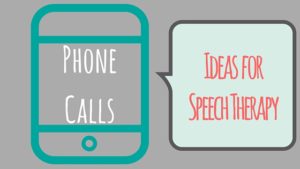Today, I’m talking about how answering phone calls and handling information from the phone call can be used in speech therapy. This is the other half of the idea I shared a few weeks ago for practice making low-pressure phone calls. Making a phone call can be a little more controlled than answering a phone call where the caller has control of the content, so both skills are good to practice! Read on for key questions to make this task person-centered, how to use this activity to target a therapy goal, and a free printable of practice situations /content you can use in therapy.
 Phone Calls + Person-Centered Care:
Phone Calls + Person-Centered Care:
In order to be sure this therapy activity is person-centered, here are some questions you could ask to decide what types of phone calls to practice:
- “What phone calls do you need to answer in your day-to-day life? What sort of information do you need to remember from those phone calls?”
- “Do you have any phone calls to make or voicemails to listen to that we could use today in therapy, to target *** (goal)?”
- “Are there friends/family/coworkers that you could ask to call you about *** for home practice in therapy, to target *** (goal)?”
- “Is everything going okay when you make or answer a phone call? Is there anything you hope to improve?”
Answering a Phone Call for Information:
I physically leave the room and call the patient from another (nearby) phone within the facility when practicing these tasks. Beforehand, we talk about specific skills or strategies that we are attempting to practice, and following the call, we review and modify the plan as needed. Here are some ideas of calls to use in therapy. Feel free to modify or create your own scenarios personalized to the goals and person you are working with:
Free Printable For You: Answering Phone Calls Practice Scenarios
Sample Therapy Ideas:
I hope these ideas are useful or help you easily target a person-centered goal! If you would like other ideas like this, please check out my Home Sweet Home Series.
| To Target Strategies or Skills in This Area: | The Patient Could Do This: |
| Verbal Expression | *Use word-finding strategies with new or unfamiliar listeners
*Participate in unscripted dialogue *Practice script training with new listeners (ex: greeting for answering the phone, asking for repetition, etc) *Summarize new information learned in phone call |
| Written Expression | *Write out/script phone conversation or questions to assist with organizing information
*Write a summary of new information learned in phone call |
| Auditory Comprehension | *Rapid listening and following instructions for phone tree navigation
*Comprehend new information over 5-minute phone call *Use of breakdown/repair strategies *Use of writing notes to improve comprehension |
| Reading Comprehension | *Locate appropriate phone number and read correctly to dial correctly |
| Motor Speech | *Challenge ability to carry-over motor speech strategy or skill over phone call environment |
| Attention | *Sustain attention: Listen to phone tree options and navigate successfully. Sustain attention for xx minutes of phone call conversation.
*Divide attention: Write notes about phone call information while talking on the phone |
| Memory | *Short-term recall for new information gained from phone call |
| Thought Organization | *Organize list of questions or comments to include in conversation, to improve efficiency and outcome |
| Problem-Solving / Reasoning | *Know how to repair conversation if not heard, understood, or if mis-understood
*Generate appropriate follow-up questions to ask in conversation |
| Executive Function | *Evaluate strategy success during task, or plan how to adapt strategies for new situation.
*Plan home program task that could be a similar challenge |
| Pragmatics | *Understand non-verbal cues and emotions of speaker
*Use appropriate turn taking. |
Bonus: Next time the phone rings during your speech therapy session, let the person answer and view interactions through a therapeutic lens!
If you want more ideas of how to make your therapy functional and person-centered, check out the Home Sweet Home Series and Functional Toolbox posts (Garden Seed Packets, Tool Kit, Cookbook).
Make sure you get the latest functional therapy updates: “Like” Honeycomb Speech Therapy on Facebook or Pinterest, or sign up for email updates.